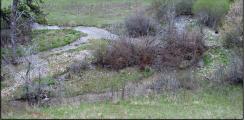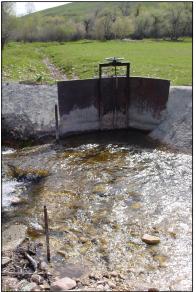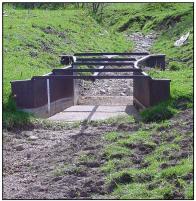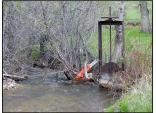Wyoming State Water Plan
Wyoming State Water Plan
Wyoming Water Development Office
6920 Yellowtail Rd
Cheyenne, WY 82002
Phone: 307-777-7626

Wyoming Water Development Office
6920 Yellowtail Rd
Cheyenne, WY 82002
Phone: 307-777-7626



| SUBJECT: | Appendix A Irrigation Diversion Operation and Description PASS CREEK |
| PREPARED BY: | HKM Engineering Inc. |
| DATE: | March 2002 |
PASS CREEK
ACME DITCH DIVERSION
CHURCH DITCH DIVERSION
SUMMIT DITCH DIVERSION
TSCHIRGI NO.2 DITCH DIVERSION
PASS CREEK DRAINAGE
INTRODUCTION
BACKGROUND
Pass Creek flows generally northeast out of the Bighorn Mountains, draining the slope north of Columbus Creek and west of Twin Creek through several tributaries of West and East Pass creeks. Eventually, after they cross the Montana border to the north, West and East Pass creeks become Pass Creek, incorporate Twin Creek, and join the Little Bighorn. The only reservoirs in Wyoming on the Pass Creek drainage lie on the benches below the mountains.
CHARACTERISTICS
Pass Creek’s drainage within Wyoming is precipitous for the most part, crossing little irrigable land in the state. Because so little land in Wyoming can be served by the drainage, it supports few major irrigation draws on its flows.
The slope of Pass Creek’s channels in Wyoming lend themselves to little loss in Wyoming. In addition, little channel length exists in Wyoming, and West and East Pass Creek are lined with heavy clays, reducing instream losses further. Finally, extensive pressurized (piped) sprinkler usage in larger irrigating operations severely reduces losses in ditches and as a result, also severely reduces return flows.
Pass Creek drainage includes a relatively large number and high volume of reservoirs in the lands below the Bighorn Mountains and south of the Montana border.
USAGE
Pass Creek’s diversions are entirely devoted to agricultural irrigation. An 1885 milling appropriation has been inactive since the decline of the wood-cutting activity in the area.
Regulation
The Pass Creek typically doesn't operate under regulation.
Agriculture
Growers in the Pass Creek drainage tend to devote approximately 50 percent of their lands to alfalfa and 50 percent to grass hay. Their irrigation practices are detailed in the individual diversion memoranda below.
The typical irrigation season runs from April 15-May 1 (depending on whether the spring runoff is delayed by colder weather) to mid-September (depending on when the first snows fall and the ground freezes). Pass Creek drainage irrigators typically don’t use post-season irrigation.
Double Appropriation
Irrigation water rights with priority dates of March 1, 1945 or earlier are entitled to an additional 1cfs per 70 acres under Wyoming’s surplus water statutes. Whenever the supply in a stream exceeds the amount required to satisfy all existing appropriations established prior to March 1, 1985, the stream is said to be in an excess flow condition and water right holders with priorities between March 2, 1945 and March 1, 1985 may use an additional 1 cfs for each 70 acres irrigated.
In Pass Creek, this practice is limited primarily by the drainage area containing arable lands within Wyoming. Though irrigators could draw twice their allocation, they don’t appear to need it for their crops.
Permitted Uses
Permits granted for water appropriation are granted for specific uses. The following pages contain tables of permits and their associated uses. The following table provides a key to those uses:
| Code | Use |
|---|---|
| Chem | Chemical |
| Com | Commercial |
| Cul | Culinary |
| D | Domestic |
| Drl | Drilling |
| Eng | Steam Engines |
| Fire | Fire Protection |
| Fish | Fish Propogation |
| F.C. | Flood Control |
| I | Irrigation |
| Ind | Industrial |
| I.F. | Instream Flow |
| Mech | Mechanical |
| Mfg | Manufacturing |
| Mil | Milling |
| Min | Mining |
| Misc | Miscellaneous |
| Mun | Municipal |
| Oil | Oil Refining or Production |
| P.C. | Pollution Control |
| Power | Power Development |
| R.R. | Railroad |
| Rec | Recreational |
| Ref | Refining |
| Res. Supply | Supply Facility for a Reservoir |
| S | Stock |
| T | Transportation |
WATER RIGHTS
Two water rights summary tables are provided for each diversion serving irrigation referenced here. The first, included in the body of the diversion synopsis, refers to the rights on record with the State Engineer’s Office and is derived from that office’s Tabulation of Adjudicated Surface Water Rights of the State of Wyoming, Water Division Number Two (Oct. 1999).
Because this rights summary is pulled directly from the SEO Tab, the rights cited follow the SEO’s priority order:
| Hierarchy | Format of right | Example |
|---|---|---|
| 1 | Day, Month, Year | 05-15-1884 |
| 2 | Month and Year | 05-00-1884 |
| 3 | Specified Season and Year | Spring 1884 |
| 4 | Year Only | 1884 |
| 5 | Before Year | Before 1884 |
Board orders or court orders may also establish a specific priority.
Irrigated Lands Water Rights Database
The second table, which follows the diversion synopsis, is taken from the irrigated lands water rights database developed for the basin plan. It can be used as a reference with the following caveats: It only lists water rights associated with the irrigated lands polygons mapped by HKM. The table does not include nonirrigation rights devoted to reservoir supply, municipal, fish propagation, etc. The rights on this table are associated only with those irrigated lands identified through the course of this study, both actively irrigated and currently idle.
| Column Heading Key | ||
| PerNo | Permit Number | "Terr" denotes a territorial right. |
| PerSfx | Permit Suffix | D = direct flow |
| E = enlargement | ||
| R = reservoir | ||
| Facility Name | Parantheses denote the former means of conveyance for the water right. | |
| Unit | Flow or volume | CFS = cubic feet per second |
| AF = acre-feet | ||
| GPM = gallons per minute | ||
| SupTyp | Supply Type | OS = original supply |
| SS = supplement supply, for lands having an original supply from another source. | ||
| Sec = secondary supply, for water stored in a reservoir | ||
| Status | Status of adjudication | Adj = adjudicated |
| Una = unadjudicated | ||
| Source | Source water | Parantheses denote the permit number of the related storage right. |
| Diversion: | ACME DITCH DIVERSION |  Acme Ditch diversion(West Pass Creek begins at the top left of the photo, Acme Ditch begins at the bottom left) |
||||||||||||||||||||||||||||||
| Date: | 9 May 2001 | |||||||||||||||||||||||||||||||
| Notes: | Soils along ditch include much clay. Slow, long ditch with essentially only two active users. From reports, maintenance has been a problem and irrigation activity has declined considerably. | |||||||||||||||||||||||||||||||
| Diversion Description: | No control structure is evident. The diversion consists of a braided stream channel that diverges, one fork as West Pass Creek, the other as the Acme Ditch. No measurement devices could be found. | |||||||||||||||||||||||||||||||
| Diversion Location: | The Acme Ditch diversion is located on the North Fork of West Pass Creek, just upstream from the X. X. Ranch. West Pass becomes Pass Creek in Montana, where it also joins the Little Bighorn River and eventually, the Yellowstone River. | |||||||||||||||||||||||||||||||
|
||||||||||||||||||||||||||||||||
| Conveyance Description: | Open channel canal, approximately 11.0 mi. long. | |||||||||||||||||||||||||||||||
| Direct Flow Water Rights: |
In recent years, active irrigation has fallen off considerably, to approximately half of the original appropriation. The summary of direct flow rights follows:
|
|||||||||||||||||||||||||||||||
| Associated Storage Rights: | No significant storage rights are permitted on
the Acme. |
|||||||||||||||||||||||||||||||
| Irrigation Practices: | In the past 10 years, sprinklers have been
removed in favor of 100 percent ditch_flood irrigation. |
|||||||||||||||||||||||||||||||
| Return Flows: | Estimated percentage of total diversion developing into return flows: | |||||||||||||||||||||||||||||||
|
||||||||||||||||||||||||||||||||
| Losses: | 30 percent by end |
|||||||||||||||||||||||||||||||
| References: | David Hannahs, X Bar X ranch manager,
interview, 29 Jan. 2001 Ken Kearns, local landowner, interview, 2 Jan. 2001 |
|||||||||||||||||||||||||||||||
Irrigated Lands Water Rights Database
| PerNo | PerSfx | Facility Name | Priority | Acres | Amount | Unit | SupTyp | Status | Source |
|---|---|---|---|---|---|---|---|---|---|
| Terr | D | Acme |
July 5, 1889 |
335 |
4.76 |
CFS | OS | Adj | West Pass Creek or Cave Creek |
| 5712 |
E |
Enl. Acme |
Dec. 9, 1953 |
61 |
0.87 |
CFS | OS | Adj | West Pass Creek or Cave Creek |
| 21336 |
D |
Acme |
Dec. 9, 1953 |
96 |
OS | Una |
Branch (North Fork) West Pass Creek |
| Name Source District Data |
Acme Ditch
Diversion West Pass Creek 6 Total monthly flow in AF |
||||||||||||
| Water Year | Oct | Nov | Dec | Jan | Feb | Mar | Apr | May | Jun | Jul | Aug | Sep | Total |
|---|---|---|---|---|---|---|---|---|---|---|---|---|---|
| 1970 | |||||||||||||
| 1971 | |||||||||||||
| 1972 | |||||||||||||
| 1973 | |||||||||||||
| 1974 | 0.00 |
7.44 |
71.72 |
68.61 |
0.00 |
147.77 |
|||||||
| 1975 | |||||||||||||
| 1976 | |||||||||||||
| 1977 | |||||||||||||
| 1978 | |||||||||||||
| 1979 | |||||||||||||
| 1980 | |||||||||||||
| 1981 | |||||||||||||
| 1982 | |||||||||||||
| 1983 | |||||||||||||
| 1984 | 38.81 |
169.46 |
184.46 |
182.55 |
103.07 |
678.35 |
|||||||
| 1985 | |||||||||||||
| 1986 | 35.70 |
119.01 |
100.42 |
81.31 |
29.01 |
365.45 |
|||||||
| 1987 | 52.31 |
75.12 |
0.00 |
0.00 |
0.00 |
127.43 |
|||||||
| 1988 | |||||||||||||
| 1989 | |||||||||||||
| 1990 | |||||||||||||
| 1991 | |||||||||||||
| 1992 | |||||||||||||
| 1993 | |||||||||||||
| 1994 | |||||||||||||
| 1995 | |||||||||||||
| 1996 | |||||||||||||
| 1997 | 69.36 |
90.61 |
41.58 |
23.95 |
23.24 |
248.74 |
|||||||
| 1998 | 171.32 |
221.21 |
149.91 |
76.61 |
30.90 |
649.95 |
|||||||
| 1999 | 0.00 |
50.83 |
81.87 |
59.31 |
0.00 |
192.01 |
|||||||
| Mean | 52.50 |
104.81 |
89.99 |
70.33 |
26.60 |
344.24 |
|||||||
| Max | 171.32 |
221.21 |
184.46 |
182.55 |
103.07 |
678.35 |
|||||||
| Min | 0.00 |
7.44 |
0.00 |
0.00 |
0.00 |
127.43 |
|||||||
| Name Source District Data |
ACME Ditch
Diversion West Pass Creek 6 First & Last Dates, Max. Days |
||
| Water Year | First Date of Measurement | Last Date of Measurement | Maximum Days Missing |
|---|---|---|---|
| 1970 | |||
| 1971 | |||
| 1972 | |||
| 1973 | |||
| 1974 | 28-Jun |
31-Aug |
0 |
| 1975 | |||
| 1976 | |||
| 1977 | |||
| 1978 | |||
| 1979 | |||
| 1980 | |||
| 1981 | |||
| 1982 | |||
| 1983 | |||
| 1984 | 23-May |
22-Sep |
31 |
| 1985 | |||
| 1986 | 23-May |
13-Sep |
28 |
| 1987 | 18-May |
26-Jun |
28 |
| 1988 | |||
| 1989 | |||
| 1990 | |||
| 1991 | |||
| 1992 | |||
| 1993 | |||
| 1994 | |||
| 1995 | |||
| 1996 | |||
| 1997 | 21-May |
23-Sep |
22 |
| 1998 | 07-May |
18-Sep |
24 |
| 1999 | 17-Jun |
23-Aug |
28 |
| Avg. | 28-May |
31-Aug |
23 |
| Earliest | 07-May |
26-Jun |
0 |
| Latest | 28-Jun |
23-Sep |
31 |
| Diversion: | CHURCH DITCH DIVERSION |
 Church Ditch headgate |
||||||||||||||||||
| Date: | 9 May 2001 | |||||||||||||||||||
| Notes: |
The soil in the Church Ditch’s channel is composed of loam
from East Pass Creek to Twin Creek, where it becomes clays. |
|||||||||||||||||||
| Diversion Description: | Headgate consists of a circular steel gate in
steel slides operated with a Waterman-type screw in a newly poured
concrete headwall. (Diverts through 2-ft. diameter corrugated metal
pipe.) |
|||||||||||||||||||
| Diversion Location: | The Church Ditch diversion is located on East
Pass Creek, just downstream from its confluence with Taffner Creek.
East Pass becomes Pass Creek in Montana, where it also joins the Little
Bighorn River and eventually, the Yellowstone River. |
 Church Ditch. flume |
||||||||||||||||||
|
||||||||||||||||||||
| Conveyance Description: | Open channel canal, approximately 6.5 mi. long. | |||||||||||||||||||
| Direct Flow Water Rights: |
Note: Recent changes in points of use have split the Church Ditch rights up throughout the lands in the Twin Creek Unit of the Sunlight Ranch. Approximately 40 percent of that acreage (and use) has actually been moved into Montana. Approximately 35 percent remains under the Church Ditch, and 25 percent has been moved to under the Summit Ditch. |
|||||||||||||||||||
| Associated Storage Rights: | Fills Reynolds No. 1 and 2 Reservoirs | |||||||||||||||||||
| Irrigation Practices: | Approximately 70% sprinkler, 30 percent ditch-flood irrigation | |||||||||||||||||||
| Return Flows: | Estimated percentage of total diversion developing into return flows: | |||||||||||||||||||
|
||||||||||||||||||||
| Losses: | Approximately 10 percent by the end of the ditch | |||||||||||||||||||
| References: | Ken Kearns, local landowner, Interview, 2 Jan.
2001 Twin Creek Ranch IrrigationSystem Rehabliliation, HKM Associates, June 1985 |
|||||||||||||||||||
Irrigated Lands Water Rights Database
| PerNo | PerSfx | Facility Name | Priority | Acres | Amount | Unit | SupTyp | Status | Source |
|---|---|---|---|---|---|---|---|---|---|
| Terr | D | Church |
Aug 31, 1886 |
714 |
10.02 |
CFS | OS | Adj | East Pass Creek |
| Terr | D | Church 2nd Appr. |
Dec. 31, 1887 |
5 |
0.07 |
CFS | OS | Adj | East Pass Creek |
| Name Source District Data |
Church
Ditch
Diversion East Pass Creek 6 Total monthly flow in AF |
||||||||||||
| Water Year | Oct | Nov | Dec | Jan | Feb | Mar | Apr | May | Jun | Jul | Aug | Sep | Total |
|---|---|---|---|---|---|---|---|---|---|---|---|---|---|
| 1970 | |||||||||||||
| 1971 | |||||||||||||
| 1972 | |||||||||||||
| 1973 | |||||||||||||
| 1974 | 0.00 |
0.00 |
38.30 |
126.09 |
0.00 |
164.39 |
|||||||
| 1975 | |||||||||||||
| 1976 | |||||||||||||
| 1977 | |||||||||||||
| 1978 | |||||||||||||
| 1979 | |||||||||||||
| 1980 | |||||||||||||
| 1981 | |||||||||||||
| 1982 | |||||||||||||
| 1983 | |||||||||||||
| 1984 | 0.00 |
24.24 |
225.67 |
244.04 |
146.71 |
640.66 |
|||||||
| 1985 | |||||||||||||
| 1986 | 0.00 |
0.00 |
140.78 |
112.11 |
0.00 |
252.89 |
|||||||
| 1987 | |||||||||||||
| 1988 | |||||||||||||
| 1989 | |||||||||||||
| 1990 | |||||||||||||
| 1991 | |||||||||||||
| 1992 | |||||||||||||
| 1993 | 0.00 |
0.00 |
0.00 |
11.54 |
84.68 |
96.22 |
|||||||
| 1994 | |||||||||||||
| 1995 | |||||||||||||
| 1996 | |||||||||||||
| 1997 | 0.00 |
41.86 |
127.47 |
189.87 |
186.02 |
545.22 |
|||||||
| 1998 | 140.99 |
||||||||||||
| 1999 | 0.00 |
0.00 |
41.22 |
227.83 |
0.00 |
269.05 |
|||||||
| Mean | 20.14 |
11.02 |
95.57 |
151.91 |
69.57 |
328.07 |
|||||||
| Max | 140.99 |
41.86 |
225.67 |
244.04 |
186.02 |
640.66 |
|||||||
| Min | 0.00 | 0.00 | 0.00 | 11.54 |
0.00 | 96.22 |
|||||||
| Name Source District Data |
Church Ditch
Diversion East Pass Creek 6 First & Last Dates, Max. Days |
||
| Water Year | First Date of Measurement | Last Date of Measurement | Maximum Days Missing |
|---|---|---|---|
| 1970 | |||
| 1971 | |||
| 1972 | |||
| 1973 | |||
| 1974 | 29-Jul |
31-Aug |
0 |
| 1975 | |||
| 1976 | |||
| 1977 | |||
| 1978 | |||
| 1979 | |||
| 1980 | |||
| 1981 | |||
| 1982 | |||
| 1983 | |||
| 1984 | 27-Jun |
22-Sep |
31 |
| 1985 | |||
| 1986 | 12-Jul |
20-Aug |
23 |
| 1987 | One Reading |
One Reading |
One Reading |
| 1988 | |||
| 1989 | |||
| 1990 | |||
| 1991 | |||
| 1992 | |||
| 1993 | 27-Aug |
28-Sep |
32 |
| 1994 | |||
| 1995 | |||
| 1996 | |||
| 1997 | 03-Jun |
16-Sep |
36 |
| 1998 | 11-May |
15-Sep |
91 |
| 1999 | 15-Jul |
23-Aug |
12 |
| Avg. | 04-Jul |
08-Sep |
32 |
| Earliest | 11-May |
20-Aug |
0 |
| Latest | 27-Aug |
28-Sep |
91 |
| Diversion: | SUMMIT DITCH DIVERSION |  Summit Ditch Headgate |
||||||||||||||||||||||||||||||||||||||||||||||||||||||||||||
| Date: | 9 May 2001 | |||||||||||||||||||||||||||||||||||||||||||||||||||||||||||||
| Note: | The Parshall flume used to measure flows through this ditch appears to be in poor condition and is actually being bypassed by much of the flow. | |||||||||||||||||||||||||||||||||||||||||||||||||||||||||||||
| Diversion Description: | Headgate consists of a circular steel gate in steel slides operated with a Waterman-type screw. (Diverts through 2-ft. diameter corrugated metal pipe.) | |||||||||||||||||||||||||||||||||||||||||||||||||||||||||||||
| Diversion Location: | The Summit Ditch diversion is located on East Pass Creek, just downstream from the Church Ditch diversion. East Pass becomes Pass Creek in Montana, where it also joins the Little Bighorn River and eventually, the Yellowstone River. | |||||||||||||||||||||||||||||||||||||||||||||||||||||||||||||
|
 Summit Ditch Flume |
|||||||||||||||||||||||||||||||||||||||||||||||||||||||||||||
| Conveyance Description: | Open channel canal, approximately 33.0 mi. long (inside Wyoming). | |||||||||||||||||||||||||||||||||||||||||||||||||||||||||||||
| Direct Flow Water Rights: |
|
|||||||||||||||||||||||||||||||||||||||||||||||||||||||||||||
| Associated Storage Rights: | No significant storage rights are permitterd on the Summit. | |||||||||||||||||||||||||||||||||||||||||||||||||||||||||||||
| Irrigation Practices: | 100 percent ditch-flood | |||||||||||||||||||||||||||||||||||||||||||||||||||||||||||||
| Return Flows: | Estimated percentage of total diversion developing into return flows: | |||||||||||||||||||||||||||||||||||||||||||||||||||||||||||||
|
||||||||||||||||||||||||||||||||||||||||||||||||||||||||||||||
| Losses: | Approximately 30 percent by the end of the ditch | |||||||||||||||||||||||||||||||||||||||||||||||||||||||||||||
| References: | Ken Kearns, local landowner, Interview, 2 Jan.
2001 Twin Creek Ranch Irrigation System Rehabilitation, HKM Associates, June 1985 |
|||||||||||||||||||||||||||||||||||||||||||||||||||||||||||||
Irrigated Lands Water Rights Database
| PerNo | PerSfx | Facility Name | Priority | Acres | Amount | Unit | SupTyp | Status | Source |
|---|---|---|---|---|---|---|---|---|---|
| Terr |
D |
Summit (Denius Sprinkler System) |
March 31, 1887 |
445 |
7.22 |
CFS | OS | Adj | East Pass Creek |
| Terr |
D |
Summit (Denius Sprinkler System) |
April 1, 1887 |
445 |
7.22 |
CFS |
OS | Adj | East Pass Creek |
| Name Source District Data |
Summit
Ditch
Diversion East Pass Creek 6 Total monthly flow in AF |
||||||||||||
| Water Year | Oct | Nov | Dec | Jan | Feb | Mar | Apr | May | Jun | Jul | Aug | Sep | Total |
|---|---|---|---|---|---|---|---|---|---|---|---|---|---|
| 1970 | |||||||||||||
| 1971 | |||||||||||||
| 1972 | |||||||||||||
| 1973 | |||||||||||||
| 1974 | 0.00 |
1.77 |
15.93 |
26.68 |
0.00 |
44.38 |
|||||||
| 1975 | |||||||||||||
| 1976 | |||||||||||||
| 1977 | |||||||||||||
| 1978 | |||||||||||||
| 1979 | |||||||||||||
| 1980 | |||||||||||||
| 1981 | |||||||||||||
| 1982 | |||||||||||||
| 1983 | |||||||||||||
| 1984 | |||||||||||||
| 1985 | |||||||||||||
| 1986 | |||||||||||||
| 1987 | |||||||||||||
| 1988 | |||||||||||||
| 1989 | |||||||||||||
| 1990 | |||||||||||||
| 1991 | |||||||||||||
| 1992 | |||||||||||||
| 1993 | |||||||||||||
| 1994 | |||||||||||||
| 1995 | |||||||||||||
| 1996 | |||||||||||||
| 1997 | 0.00 |
70.33 |
203.89 |
155.91 |
96.83 |
526.96 |
|||||||
| 1998 | 102.70 |
149.95 |
130.89 |
166.26 |
75.17 |
624.97 |
|||||||
| 1999 | 0.00 |
23.70 |
50.78 |
38.48 |
0.00 |
112.96 |
|||||||
| Mean | 25.68 |
61.44 |
100.37 |
96.83 |
43.00 |
327.32 |
|||||||
| Max | 102.70 |
149.95 |
203.89 |
166.26 |
96.83 |
624.97 |
|||||||
| Min | 0.00 | 1.77 |
15.93 |
26.68 |
0.00 | 44.38 |
|||||||
| Name Source District Data |
Summit Ditch
Diversion East Pass Creek 6 First & Last Dates, Max. Days |
||
| Water Year | First Date of Measurement | Last Date of Measurement | Maximum Days Missing |
|---|---|---|---|
| 1970 | |||
| 1971 | |||
| 1972 | |||
| 1973 | |||
| 1974 | 28-Jun |
31-Aug |
0 |
| 1975 | |||
| 1976 | |||
| 1977 | |||
| 1978 | |||
| 1979 | |||
| 1980 | |||
| 1981 | |||
| 1982 | |||
| 1983 | |||
| 1984 | |||
| 1985 | |||
| 1986 | |||
| 1987 | |||
| 1988 | |||
| 1989 | |||
| 1990 | |||
| 1991 | |||
| 1992 | |||
| 1993 | |||
| 1994 | |||
| 1995 | |||
| 1996 | |||
| 1997 | 03-Jun |
23-Sep |
42 |
| 1998 | 05-May |
15-Sep |
22 |
| 1999 | 17-Jun |
23-Aug |
28 |
| Avg. | 05-Jun |
07-Sep |
23 |
| Earliest | 05-May |
23-Aug |
0 |
| Latest | 28-Jun |
23-Sep |
42 |
| Diversion: | TSCHIRGI NO. 2 DITCH DIVERSION | |||||||||||||||||||||||||||||||
| Date: | 29 Jan 2001 | |||||||||||||||||||||||||||||||
| Diversion Description: | Now a pumping diversion. |
|||||||||||||||||||||||||||||||
| Diversion Location: | The Tschirgi No. 2 Ditch diversion is located on West Pass Creek. West Pass becomes Pass Creek in Montana, where it also joins the Little Bighorn River and eventually, the Yellowstone River. | |||||||||||||||||||||||||||||||
| Conveyance Description: | Pressurized pipeline. |
|||||||||||||||||||||||||||||||
| Direct Flow Water Rights: | The summary of direct flow rights follows:
Note: Current irrigators note that pumping rates have tapped approximately 4 cfs of the right in the past few years, but that plans to open the Tschirgi No. 2 ditch again and install new pumps mean increases in use of right. |
|||||||||||||||||||||||||||||||
| Associated Storage Rights: | None |
|||||||||||||||||||||||||||||||
| Irrigation Practices: | Approximately 5 percent of irrigation is done by
“big gun,” single-head sprinklers, 5 percent by hand-line sprinklers,
50 percent by sideroll, and the remaining 40 percent is done with gated
pipe. |
|||||||||||||||||||||||||||||||
| Return Flows: | Estimated percentage of total diversion developing into return flows: | |||||||||||||||||||||||||||||||
|
||||||||||||||||||||||||||||||||
| Losses: | None (Pumping diversions have no conveyance
losses.) |
|||||||||||||||||||||||||||||||
| References: | Ken Kearns, local landowner, Interview, 2 Jan.
2001 Paula Luschen, owner, and Hal Iverson, ranch manager, West
Pass Creek Ranch, telephone interview, 31 Jan. 2001 |
|||||||||||||||||||||||||||||||
Irrigated Lands Water Rights Database
| PerNo | PerSfx | Facility Name | Priority | Acres | Amount | Unit | SupTyp | Status | Source |
|---|---|---|---|---|---|---|---|---|---|
| 973 |
E |
Enl. Tschirgi No. 2 (Nicholson West Pass Pump) |
Jan 26, 1903 |
644 |
9.19 |
CFS | OS | Adj | West Pass Creek |